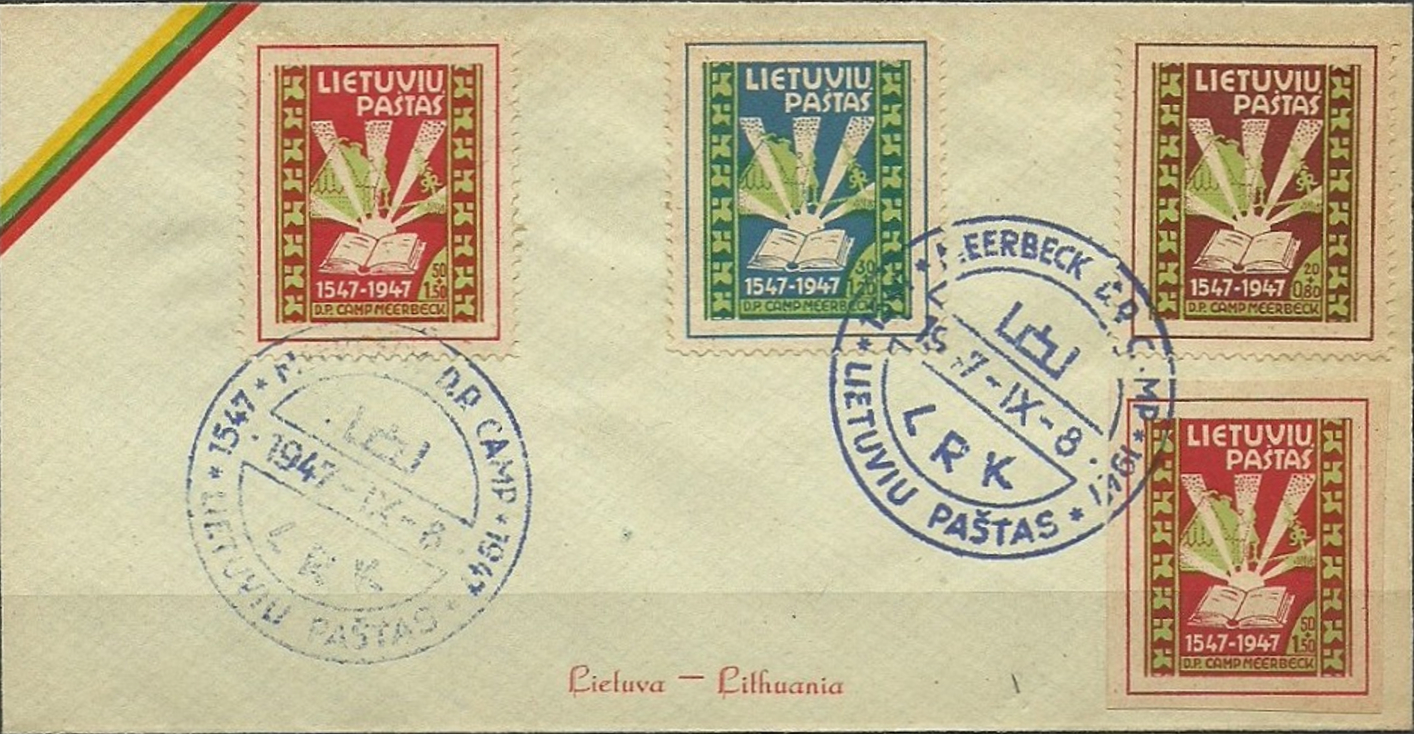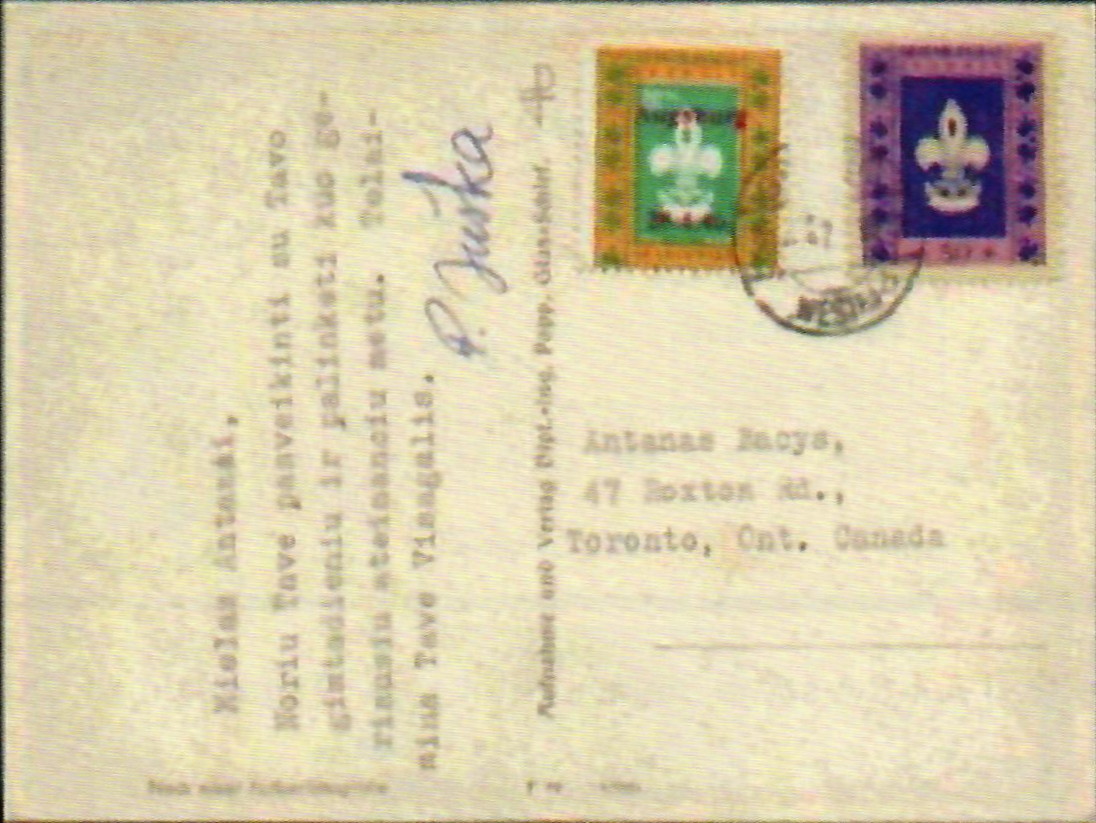Lithuania
-
Royal Polish Post
-
Imperial Russian Post
-
German Occupation / Ob. Ost
-
Independent Republic of Lithuania
-
Central Lithuania
-
Memel Area / Klaipėda
-
Soviet Occupation
-
German Occupation / Ostland
-
Camp Mail / Lithuanians in Exile
For general information on DP camps, mail from camp inmates to other camps, at home and abroad, and the issue of camp postage stamps, see Camp Mail / Estonians in Exile on this web.
Lithuanian DP camps
In November 1946, 58,000 Lithuanians were being cared for by UNRRA in a total of 263 camps, 31,000 lived in the American zone, 24,500 in the British zone and 2,400 in the French zone. To these must be added – according to unofficial estimates – about 10,000 persons who were living in private homes.
February 16, the day of Lithuania's declaration of independence (1918), was one of the most important holidays in all Lithuanian kindergartens, primary schools and high schools. The Scout academic movement organised commemorative ceremonies at the Baltic University on that day. In most Lithuanian camps, these commemorations were organised on the initiative of the Lithuanian refugee community, with the participation of UNRRA leaders, representatives of the Latvian and Estonian communities. Folk art exhibitions were organised for the occasion, theatre plays were performed and special concert programmes for folk art ensembles were prepared. The most active celebrations took place in Würzburg, Seligenstadt and Munich, while the celebration in the Lithuanian Colony in Augsburg in 1946 gathered as many as 2000 participants and guests.
Lithuanian Camp Post Stamps
In addition to the "Baltic" camp post issues in Altenstadt/Schongau, Augsburg-Hochfeld, Hanau and Kempten, there were also purely Lithuanian camp post stamps in Augsburg, Detmold, Meerbeck and Seedorf (cf. the general details under Camp mail / Estonians in Exile).

(Like three quarters of all letters with PAID postmark) philatelically influenced (multiple set) letter with the sets issued in Seedorf in similar presentation. As the letter ran from DP camp to DP camp in the British zone, it was postage paid, the stamps are all just commemorative vignettes with courtesy cancellation "SEEDORF PAŠTAS". Delivery was processed via the post office in Stadthagen, which cancelled the Stadthagen day stamp on the envelope with the red stamp "MEERBECK Displaced Persons M a i l Paid" (the most common PAID stamp) delivered to the camp inmates..
Lithuanians in exile
From 1947 onwards, mass emigration began, opening the way to the Canadian (about 20,000 Lithuanians), Australian (10,000 Lithuanians), Argentinian (about 800 Lithuanians), Brazilian (700 Lithuanians), Colombian (500 Lithuanians) and New Zealand (250 Lithuanians) labour markets. But the most attractive country, with the oldest Lithuanian immigration history (the first Lithuanians settled here in the 18th century), was the USA. By immigration law, the USA accepted 30,000 Lithuanians. Later, some of the Lithuanians who had previously emigrated to Great Britain, Belgium, Canada or Australia also moved to the USA and stayed here for a longer period of time, joining the ranks of the Lithuanian communities in the USA.
Some of the Lithuanians remained in Germany even after the end of the DP period. Mainly thanks to their efforts, the LTB (Lithuanian Refugee Community) was reorganised into a German-Lithuanian community. Regional Lithuanian communities were established sooner or later in all major Lithuanian clusters, they were all united by the Lithuanian World Community, which is believed to have started its activities in 1949 when the Lithuanian Charter was proclaimed (source: www.archiv.org.lv/baltic_dp_germany).
Lithuanian communities that maintain and promote Lithuanian customs formed all over the world, e.g. the Lithuanian Foundation Inc. founded in 1961.
One philatelic group that is still active today is the Lithuanian Philatelic Society in Chicago.
Some Lithuanian artists are also associated with philately in Germany:
The artist Eduard Krasauskas designed the DP camp stamps of Augsburg and Detmold.
Vytautas Kazimieras Jonynas is known as the designer of the postage stamp issues of the states of the French Zone Baden, Rhineland-Palatinate and Wuerttemberg as well as the first Saar issues I and II. These are among the most beautiful stamps in Germany.
-
Independent Republic of Lithuania (restored)
-
Private Mail in Lithuania




